Atomic Multifunctional Submarine Cruiser: Asymmetrical Response to the West
Since the time of the USSR, asymmetric tactics have been based on the use of anti-ship missiles (PKR) launched from air, underwater and surface carriers.
Surface groupings of ships of NATO countries are built around aircraft carrier groups. Accordingly, the area of responsibility of such a group is controlled at a considerable distance at the expense of aviation reconnaissance equipment - airborne early warning aircraft (AWACS) and anti-submarine aircraft and helicopters (PLO).
The detection range of airplanes and ships by DRLO aircraft exceeds 500 km, cruise missiles - over 250 km. This allows you to destroy both the carriers and the anti-ship missiles themselves with a range of use up to 500 km by means of carrier-based aviation and air defense of surface ships. Due to the use of missiles with an active radar homing head (ARGSN) and external targeting from DRLO airplanes it is possible to damage the anti-ship missiles throughout the entire length of the flight.

The organization of air defense systems AUG USA (from the magazine "Foreign Military Review")
For anti-ship missiles with a range of applications over 500 km, such as the Dagger rocket, there is a problem of issuing sufficiently accurate coordinates for target designation. The reconnaissance satellite group capable of tracking aircraft carriers quickly, according to public information, is currently absent from Russia. In addition, in the event of a global conflict, satellites can be destroyed by anti-satellite weapons. The use of reconnaissance aircraft to accurately determine the coordinates of the AUG does not guarantee that they will not be detected or destroyed before.
Anti-submarine aircraft carrier lines exceed 400 km, but are not insurmountable, and do not guarantee one hundred percent detection of submarines. This is confirmed by the cases when the USSR submarines floated in close proximity to the AUG.
In general, submarines have significantly greater combat stability compared to surface ships, however, the target designation problem for submarines PKR is also relevant, as is the defeat of PKR missiles with ARGSN and external target designation.
Proceeding from the above, in order to counter large formations of surface ships, including carrier strike groups, I propose at a new level to implement an asymmetric concept, including new types of weapons and tactics of its use.
The basis of the concept should be a new combat unit, in functionality that combines the capabilities of a submarine and a destroyer / cruiser. The proposed provisional name is the Atomic Multifunctional Submarine Cruiser (AMPPK).
To maximize cost reduction and increase the speed of creation, I propose to implement AMPPK based on the strategic missile submarine cruiser (SSBN) of the Borey 955A project. Maximum unify the elements of the hull, power plant, hydroacoustic complex, life support systems.
SSBN project 955 "Borey"
The main differences AMPPK:
1. Replacing mines of ballistic missiles with universal vertical launchers for cruise and anti-aircraft missiles.
2. Installation of radar with an active phased antenna array (AFAR) on a lifting mast, retractable in the submerged position, allowing the use of anti-aircraft guided missiles (SAM) C-350 / C-400 / C-500 complexes
3. Installation of an optical location station, including day, night and thermal imaging channels.
4. Installation of powerful sources of interference in the radar range, based on modern solutions for the armed forces of Russia.
5. Installation of a combat information system (CICS), ensuring the use of installed weapons.
Installing a retractable mast with an AFAR radar will likely require an increase in the size of the felling. With its design it is necessary to implement a set of measures to reduce the visibility in the radar wavelength range.
Based on the mass-dimensional characteristics of the antenna arrays of the Sampson radar and the S1850M radar of the British destroyers of the Dering type, the mass of the radar with AFAR should not exceed ten tons. AFAR should be lifted to a height of ten to twenty meters. Unsolvable, this task is not seen, modern truck cranes with a telescopic boom are capable of lifting a load of about ten tons to a height of over thirty meters.
In the process of development it is possible to reduce the mass of AFAR. For example, planar AFARs developed by NIIPP have significant advantages in terms of weight and dimensions compared to other solutions. At times, the mass and thickness of the sheet AFAR decreases. This allows using them for a new class of antenna systems - conformal antenna arrays, i.e. repeating the shape of the object.
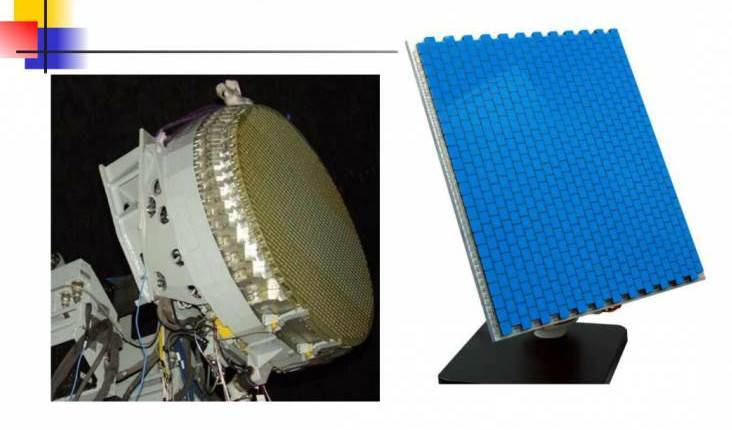
Comparison of the dimensions of the “classical” and planar AFAR (JSC “NIIPP”, Tomsk)
If, however, constructive difficulties arise with the removal of an AFAR to a specified height, it can be placed below, or even on the sides of the existing logging (conformal antennas), which will reduce the possibility of hitting low-flying targets and, accordingly, reduce the potential of AMPPK to solve some types of problems . It is possible that changes in the hull of the submarine, including the installation of large retractable structures, will require to reduce the maximum depth of the AMFPK.
Estimated amfpk ammunition should include:
- PKR "Onyx", "Caliber", "Zircon";
- SAM from the C-350 / C-400 / C-500 complexes in the "sea" version;
- long-range cruise missiles (CR) of the Caliber type for use on ground targets, possibly ballistic missiles based on Iskander operational-tactical missile complex (OTRK) missiles, if such missiles are developed / adapted for fleet;
- non-returnable unmanned aerial vehicles (UAVs), the purpose of which will be discussed further.
Preserved existing weapons used from torpedo tubes.
Unrecoverable UAVs can presumably be developed based on existing Caliber subsonic missiles. Instead of the warhead, reconnaissance equipment is installed — radar, data line, and jammers. Its mission is to search for the exact coordinates of the AUG to issue target designation of the RCC. After launching the UAV gains maximum height, carrying out a circular scanning of the water surface. After the detection of the AUG, the UAV flies in its direction, specifying the coordinates of the order ships and at the same time carrying out the jamming.
Drawing an analogy with Ohio-type submarines adapted for use of Tomahawk cruise missiles, AMPPK based on the BNR 955A SSBN should accommodate about one hundred universal launch cells.
Ohio-type SSBNs contain 24 ballistic missiles, and Ohio-type SSGNs contain 154 Tomahawk cruise missiles. Accordingly, if 955A “Borey” SSBN accommodates 16 ballistic missiles, then 154 / 24 x 16 = 102 UVPU.
Unfortunately, at the moment in the Russian fleet there is no truly universal vertical launcher, into which both cruise and anti-aircraft missiles can be loaded, or I have no information on such an installation. If this problem is not solved, then this will significantly reduce the flexibility of forming amfpk ammunition, as during the construction phase a fixed ratio of cells for cruise and anti-aircraft missiles will be determined.
In the absence of UVPU for all types of weapons planned for use, I propose to implement the universality of the weapons compartment as follows.
Starting cells KR, PKR and ZUR are mounted in specialized containers of weapons, containing the installation of vertical launch (OHR), respectively, for KR / PKR or ZUR. Weapon containers, in turn, are located in the AMFPK’s internal universal weapons compartment. Thus, by changing the composition of the containers, you can change the type of ammunition amfpk. Replacing the ammunition after it is consumed can be carried out by replacing the missiles in the CIP, and replacing the CID (containers) themselves and their further recharging outside AMPPK. The optimal size of universal weapons containers should be determined at the design stage.
Significantly increase the survival of AMPPK can the implementation of the possibility of launching all types of missile weapons (SAM) from under water. If the possibility of equipping AMPPK with a retractable mast can be constructively feasible, launching the missile defense from a depth of at least a few meters will allow AMPPK not to emerge completely, but to raise to the surface only a mast with radar and OLS.
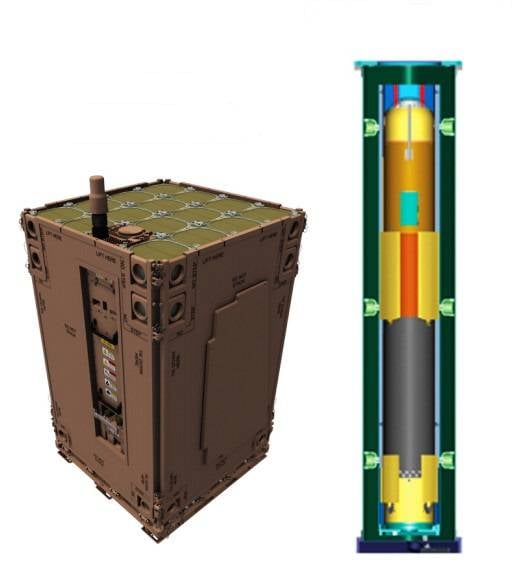
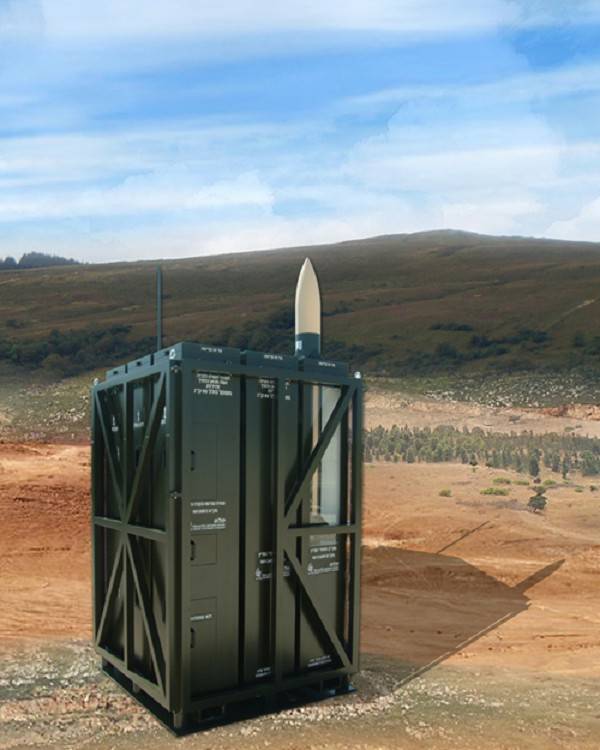
Container installations for vertical missile launch (example)
Taking the ratio as 52 cells for cruise missiles and 50 cells for anti-aircraft missiles, the following ammunition load can be formed:
- 10 cruise missiles such as "Caliber for hitting ground targets";
- 40 CRP type "Onyx", "Caliber", "Zircon";
- 30 long-range missiles on the basis of missiles of C-400 / C-500 complexes;
- 80 small / medium missiles (4 per cell) based on the missiles of the С-350 / С-400 / С-500 complexes;
- 2 non-returnable reconnaissance UAVs based on existing cruise missiles.
The composition of the ammunition is adjusted depending on the tasks solved by AMPPK. The nomenclature of weapons used from torpedo tubes is generally maintained, but can also be adjusted for the tasks.
Separately, it is necessary to consider the use of laser weapons on AMPPK. Despite the skepticism of many towards laser weapons, one cannot but note significant progress in this direction. Obtaining compact installations on fiber-optic and solid-state lasers with a power of up to one hundred kilowatts placed on automobiles suggests the possibility of creating a similar megawatted class laser complex, the weight and size characteristics of which will allow it to be placed on a submarine. The presence of a nuclear reactor as an energy source will provide the laser with the necessary power supply.
The possibility of creating such a laser weapon in Russia remains in question, since there are no reliable tests on lasers of such power. The characteristics of the Peresvet laser complex are classified, its power and purpose are unknown. The technological laser complexes based on CO2 lasers created in Russia have a power of the order of 10-20 kilowatts. IRE-Polyus, which manufactures high-power fiber-optic lasers, is formally part of IPG Phtonix and is registered in the USA, and its military products are unlikely to be used.
The reason why a laser weapon installation is generally considered at AMFPK is the combination of weapons with unlimited ammunition (with a nuclear reactor) and the possibility of destroying enemy aircraft without unmasking in the form of an anti-aircraft missile. The primary targets of the laser complex are Groomman E-2 “Hokai” DRLO aircraft, Boeing P-8 “Poseidon” type PLO aircraft and MC-4C “Triton” long-range UAV.
As part of the US Boeing YAL-1 program, the possibility of a laser of the megawatt class of launching ballistic missiles at a distance of up to 500 km was considered by a laser. Despite the closure of the program, certain results were obtained on the defeat of training ballistic targets. For AMPPK, a significantly shorter range of damage is suitable, which can be on the order of a hundred or two hundred kilometers, which makes it possible to count on a sufficiently high efficiency of the complex in good weather conditions.
In the case of a package of fiber lasers, the possibility of providing separate guidance packages can be considered. When installing five packages of 200 kilowatts, AMFPK will be able to simultaneously hit five targets simultaneously. As such, subsonic anti-ship missiles, low-flying UAVs, unarmored helicopters, motor boats and boats can be considered. If necessary, attacks of a large remote target packets are reduced to one channel / focus on one target.
In the further description of the scenarios, the use of AMPPK does not reveal the use of laser weapons. In general, it is equivalent to the use of missiles, adjusted for the specifics of the use of this type of weapon.
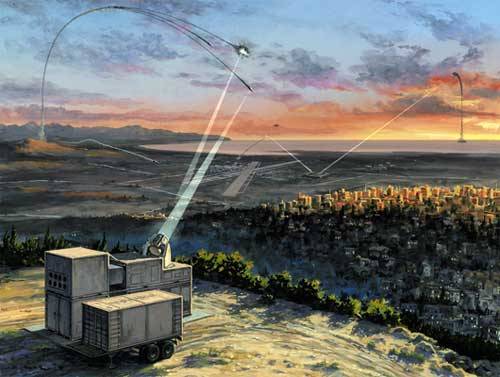
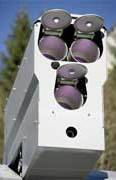
The German concern Rheinmetall has experienced a high-energy laser. The laser power is less than the minimum value required for the battlefield - 100 kW, but simultaneous targeting of several rays at a time enables weapons to achieve similar results, with the required minimum. In some cases, when there is no need for high beam power, all laser weapon modules have the ability to work on individual targets.
Of course, the development and installation of a laser complex should be considered both from the point of view of feasibility at the existing technological level, and with respect to the cost / efficiency criterion, taking into account the available developments in Russia and abroad.
The main scenarios for the use of AMPPK:
- destruction of carrier strike groups and ship formations;
- Missile defense functions (ABM) - the destruction of the launching ballistic missiles in the initial part of the trajectory in the areas of the SSBN patrols of the likely enemy;
- the destruction of anti-submarine aviation, cover SSBN;
- causing massive strikes with cruise missiles with conventional or nuclear warheads on the territory of a potential enemy;
- the destruction of transport aircraft on the flight routes, the interruption of supply lines;
- the destruction of artificial earth satellites along the optimal trajectory (if such an opportunity will be realized by the 500 С missiles);
- the destruction of cruise missiles and UAVs launched on the territory of Russia's allies in regional conflicts.
Let us consider in more detail the scenarios for the use of AMPPK.
Destruction of carrier strike groups.
The strike group consists of two AMPPKs and two multi-purpose nuclear submarines (MTSPL) of the “Ash” type (project 885 / 885М). MCCLs of the “Ash” type provide cover for AMFPK from enemy's PLA and participate in striking the anti-ship missiles on the AUG.
The preliminary location of the AUG is determined by the emission of DRLO planes or receiving data from external intelligence sources. Scanning is performed by passive antennas without submarine unmasking. In the case of the detection of DRLO planes, the group diverges, covering the AUG over a large radius. The goal is to ensure the reach of missiles to airborne early warning aircraft carrying out patrols and unnoticed to approach the AUG at the missile launch range.
Depending on the distance to the DRLO aircraft and weather conditions, a partial ascent, extension of the mast with radar and RLS and pointing the missile at the radio signal source, according to the RL or AFAR operating in LPI mode (“low signal interception capability”), is carried out. Simultaneously, the detection of PLO aircraft and helicopters, combat aircraft in the air F / A-18E, F-35.
After capturing on the support of all available targets, AMFPK performs the ascent and launch of missiles on all enemy aircraft within reach. The speed of the missile flight ranges from 1000 m / s to 2500 m / s. Based on this, the time of hitting targets will be from two to five minutes from the moment of launching the missile defense system.
Simultaneously, the launch of a non-refundable UAV. After launching the UAV gains maximum height, carrying out a circular scanning of the water surface. After the detection of the AUG, the UAV flies in its direction, specifying the coordinates of the order ships and at the same time carrying out the jamming.
Immediately after receiving the updated target designation, the RCC is launched from all submarines of the strike group. Based on the above AMFPK ammunition, the total salvo can reach up to 120 RCC (according to 40 RCC at AMPPK and according to 30 at ICAP of the “Ash” type).
Given that enemy aircraft will be destroyed or will carry out active evasion of missiles, the issuance of external target designation or the defeat of anti-aircraft missiles by aviation is unlikely. Accordingly, the ability of AUG to resist a massive attack of low-flying targets will be significantly reduced.
The average time spent on the surface after the ascent should not exceed 10-15 minutes. Then under water is carried out and concealed from the forces of the enemy. In the event of the detection of the actions of the antisubmarine aviation of the enemy, active defense can be carried out - subsurface and destruction of the enemy's aviation.
A detailed study of the tactics of use, taking into account the real characteristics of the weapons being developed, can make changes to the specified tactics. The main innovation here is the ability of AMFPK to actively counteract enemy aviation, which is the main trump card of the AUG.
Also AMPPK, in contrast to the surface ship is almost invulnerable to the RCC, since his time on the surface is small. This will limit the range of weapons used against AMPPK torpedoes and depth bombs. Taking into account the presence at AMPPK of serious air defense capabilities, this will be a difficult task for enemy aircraft.
An alternative use of AMPPK vs. AUG is clearing the sky for missile-carrying bombers before launching the anti-ship missiles. This ensures a significant reduction in the probability of damage to the carriers of anti-ship missiles and the elimination of over-the-horizon shooting at low-flying anti-ship missiles.
Implementation of missile defense (missile defense).
The basis of the strategic nuclear forces of NATO countries is the maritime component - nuclear submarines with ballistic missiles (SSBN).
The share of US nuclear warheads deployed on SSBNs over 50% of the entire nuclear arsenal (about 800 - 1100 warheads), UK - 100% of the nuclear arsenal (about 160 warheads on four SSBNs), France 100% of strategic nuclear charges (about 300 warheads about 2004 ).
Destruction of the enemy's SSBNs is one of the top priorities in the event of a global conflict. However, the task of destroying a SSBN is complicated by the concealment by the enemy of the SSBN patrol areas, the difficulty of determining its exact location and the presence of combat escort.
In the event that there is information on the approximate location of the enemy SSBNs in the world ocean, AMPPK may be on duty in the area along with hunter submarines. In the event of a global conflict, the hunter boat is assigned the task of destroying the enemy SSBNs. If this task is not completed, or the SSBN began launching ballistic missiles before the moment of destruction, AMPFK is charged with the task of intercepting the launching ballistic missiles at the initial part of the trajectory.
The ability to solve this problem depends primarily on the speed characteristics and range of the use of promising missiles from the C-500 complex, intended for anti-missile defense and the destruction of artificial earth satellites. If these capabilities are provided with missiles from the C-500, then AMPPK can realize a "blow to the head" to the strategic nuclear forces of the NATO countries.
The destruction of the launching ballistic missile in the initial part of the trajectory carries the following advantages:
1. The launching rocket cannot maneuver and has maximum visibility in the radar and thermal range.
2. The defeat of one rocket can destroy several combat units, each of which can destroy hundreds of thousands, or even millions of people.
3. To destroy a ballistic missile in the initial part of the trajectory, knowledge of the exact location of the enemy SSBNs is not required, it is sufficient to be in the range of the antimissile action.
In combination with the possibility of destroying the carriers themselves, primarily those being serviced at the docks (long-range cruise missiles), one can expect a marked decrease in the effectiveness of the use of US nuclear weapons. Under certain conditions, the complete destruction of the strategic nuclear forces of Great Britain or France is possible. It can be considered an asymmetric response to the deployment of missile defense systems near the borders of the Russian Federation.
The destruction of anti-submarine aviation, cover SSBN.
Within the framework of this task, AMFPK provides support for its own SSBNs. By ensuring the possibility of effective destruction of anti-submarine aviation and enemy surface ships, the stability of the submarine component of strategic nuclear forces can be significantly increased. Destruction of destroyers and cruisers with guided missile weapons in the launch zone of strategic ballistic missiles will prevent their defeat in the initial part of the trajectory by means of the ship's missile defense system.
Applying massive strikes with cruise missiles.
AMPPK acts like an Ohio-type SSGN. Most of the ammunition consists of long-range cruise missiles, there is only a small amount of missiles and anti-ship missiles for self-defense of AMFPK. Not the most rational task for these ships, but in some cases may be in demand. The advantage of AMPPK in this case will be the opportunity to bring the frontier of the launch of the Kyrgyz Republic closer to the shores of the enemy due to the ability to actively counteract PLO aviation.
Destruction of transport aircraft on the flight routes, interruption of supply lines by sea.
A task similar to that solved by the "Wolf Packs" of German submarines during the Second World War. Unlike Admiral Doenitz submarines, AMPPK can effectively destroy all types of targets on the water, under water (not priority) and in the air. Placing AMFPK on the flight routes of transport airplanes and the movement of sea transport in the event of a global conflict will allow “cutting” supply routes from the United States to Europe.
Opposition AMFPK will require the diversion of significant forces to protect maritime convoys. Changing the routes of movement of transport aircraft, with an increase in the length of their flight, will increase the time for delivery of cargo, will require cover by combat aircraft with anti-radar missiles and torpedoes to counter AMPPK. Also, aircraft can be destroyed tankers, which are the basis of the strategic mobility of US aircraft. A side effect will be the constant stress of the crews of airplanes, since they will not be able to withstand the powerful missiles in the ocean, a single transport aircraft or tanker is guaranteed to be destroyed.
For the escort forces, AMFPK will not be an easy target and will be able to act even against protected convoys.
Destruction of a satellite.
Provided that the C-500 air defense missile system will include missiles with the ability to destroy the satellites, the same possibility can be realized on the AMPFK. The advantages of AMPPK will be the ability to reach a position in the world ocean, which provides the optimal trajectory for hitting selected AES. Also, a launch near the Earth’s equator provides for the possibility of hitting targets at a higher altitude (the launch of cargo into orbit from the equator is used in the commercial launch site “Sea Launch”).
Destruction of cruise missiles and UAVs launched on the territory of Russia's allies in regional conflicts.
In operations similar to the company in Syria, AMPPK, carrying out duty in the region of the coast of Syria, could partially destroy cruise missiles launched across Syria in a flight above the water where the missiles cannot hide in the folds of the terrain, thereby reducing efficiency strikes of ships, submarines and planes of NATO. An additional effective means of exposure may be the use of radar interference.
The need may arise in the case when the defeat of manned carriers can provoke a global conflict, but it is necessary to maximally weaken the attack on an ally.
Based on the foregoing, it can be assumed that the creation of AMFPK will be an effective asymmetric solution of the Russian Navy to powerful naval groups of NATO countries.
At the moment, the construction of a series of SSBNs of the Borey project is being completed. In the case of the timely development of AMPPK based on the 955M project, their construction can be continued on the liberated stocks. Taking into account the experience gained in the manufacture of the Borey-type SSBN series, a lower level of technological risks can be expected than, for example, in the implementation of a project of Leader-type destroyers. The implementation of destroyers of the type "Leader" will require the creation of gas turbines that do not exist at the moment, the same project with a nuclear reactor will turn the destroyer into a cruiser, with a corresponding cost. In any case, AMPPK will have incomparably greater flexibility and combat stability compared to surface ships that are guaranteed to be detected and destroyed in the event of a collision with superior enemy forces.
For those actions where you can not do without surface ships - demonstrating the flag, escorting transport ships, supporting amphibious operations, participating in conflicts of low intensity, in my opinion, building frigates is enough, including increased displacement, like the proposed 22350M project.
The construction of a series of twelve AMPPK, staffing them with replaceable crews and carrying out timely maintenance, will allow to realize a high coefficient of operational tensions, and keep eight AMPPKs at the same time at sea.
According to information from the open press, a new generation of submarines is currently being developed in Russia. Their possible benefits include the modularity of the design, the use of newer reactors, sonar systems, less noise. It is possible, taking into account all these innovations, to implement AMFCK optimally on the basis of the design of new-generation submarines. However, due to lack of information, this option was not considered. If AMPPK is implemented on the basis of submarines of a new generation, the period of their entry into service will increase substantially, financial and technical risks will increase.Read more...
Prepared according to the materials in the open press. In preparing the article used images from the Internet.
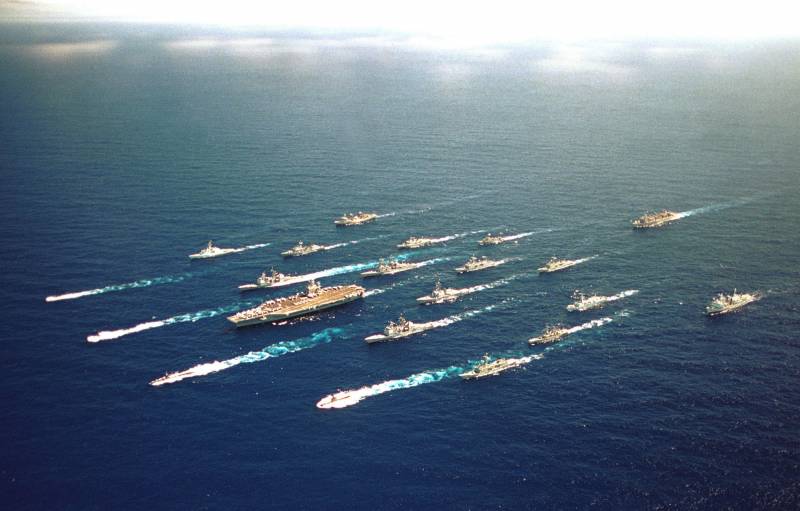
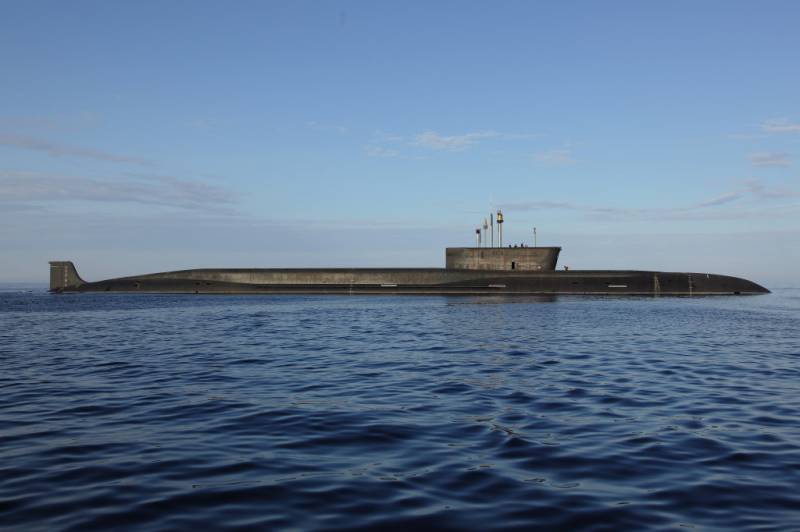
Information